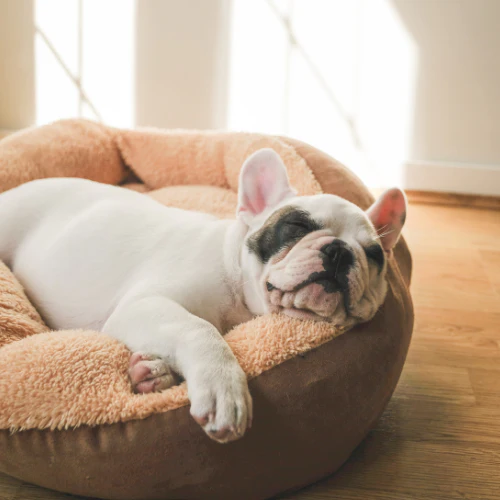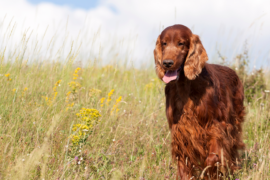Dog beds are not only an important purchase for your dog, they’re a good purchase for you, too. Research shows that having a dog sleep in the same room as you can improve your night’s sleep, but conversely having a dog sleep in the same bed as you can worsen your night’s sleep.
Sleep is vastly important for dogs of all ages, though puppies and older pets may need to sleep more often. When training your dog, if they’ve had a restful night’s sleep they’re more likely to respond well and remember your instructions. As much as good sleep is necessary for us to get through the workday, the same goes for our four-legged friends.

Are dog beds good for dogs?
People will often ask whether dog beds are good for dogs. Every family will likely have their own traditions if they’ve had dogs before, but in general, yes, dog beds are good for dogs. If not just for somewhere comfy to sleep, they’re a place of refuge from the stressors of everyday life.
Giving your dog somewhere to go on their own where they aren’t going to be disturbed is a great way to improve their mood. Especially in busy households that have either lots of adults, or a few adults and lots of children, you will need to set up a place that’s just for your dog. When they get tired of the noise and hustle and bustle, they can take themselves away for a midday nap.

Dogs sleep more often than humans, and in shorter bursts, naturally so it’s a great idea to let them do this whenever they need to. Larger breeds, senior dogs, and puppies all also need more sleep than smaller, or more in-their-prime dogs will, in general, so keep this in mind.
For larger breeds, or breeds known for hip dysplasia or joint issues, an orthopaedic mattress made from memory foam can be a great investment. Sometimes sleeping on hard surfaces can exacerbate the issues that some breeds of dogs have with their joints and bones, and a mattress that gives them the support they need is a fantastic way to relieve pain, or prolong the time they have without pain.
Of course, every dog is different. We can’t say that every dog will definitely benefit from one dog bed or another, because some dogs prefer sleeping in different ways, or prefer cosying up to their humans as much as possible. But, generally, it’s easy to come to the conclusion that dog beds are good for dogs.
Are dog beds safe for puppies?
Puppies generally need a chew-safe environment when growing. Mouthing and chewing is a very common activity for our younger dogs. Most comfy beds will have a copious amount of soft stuffing inside, which is great for comfort but can be dangerous if your puppy swallows it.
There are chew-safe beds manufactured from sturdier materials that your puppy will find it difficult to rip apart, though no toy or bed can ever be called truly “indestructible”. Puppies need a general awareness of them at all times regardless of whether they have a dog bed or not, so be sure to keep an eye on them. But, it should be safe for any puppy to stay in a dog bed.
There are different types of dog beds, and which one your dog or puppy prefers will depend entirely on their temperament. Some dogs love to curl up in a ball whilst they sleep, and others prefer stretching out across as much space as possible. Whether you go for a box bed with walls, or a more pillow-like bed that’s flat will depend on your dog’s taste. Either of these designs are suitable for and safe for puppies.

When purchasing a bed for your puppy, you might want to consider their current size versus their full-grown size. If you’re aiming for a bed that is very comfortable for a curled up pup, then you will need to go smaller so that the walls are the perfect size for your puppy. If, however, you’re more interested in a bed that will last a long time, you should consider purchasing a dog bed that’s going to let your puppy grow into it.
There’s no right or wrong in terms of size for a puppy dog bed; it’s a personal preference. You will end up spending more if you buy multiple ones as they grow, but it might be worth the comfort for your pet.
How safe are thermal dog beds?
There are two types of heated dog beds, self-warming and electric. Electrically heated dog beds work by plug, and use metal coils within the bed to warm up to a cosy temperature, it varies by manufacturer but generally 38°C (102°F) — the internal temperature of dogs. On the other hand, self-warming dog beds are made from materials that trap heat from the dog and use it to warm up the bed naturally.
Self-heating dog beds have no electrical parts or components, meaning that they are safer, but might not reach the temperatures your dog needs if they’re struggling to stay warm in truly frigid environments.
How can I wash dog beds?
The material that a dog bed is made from is an important factor in how easily you can wash a dog bed. Many dog bed manufacturers know that dog owners will want to wash the dog beds regularly and they ensure that you can do this by giving you a zipped outer portion of the bed to remove. These can often — but be sure to check the user’s manual for your purchase — be machine washed, or carefully hand-washed, depending on the material.
Other dog beds are made from a washable material that is easily wiped down; sometimes these are designed for outdoor settings more and therefore are made from slightly more durable and weatherable materials.
If the dog bed doesn’t have a removable panel or case, then check to see if the whole bed is washable. When washing a dog bed, you need to ensure that you can dry the bed thoroughly before allowing your dog to use it once more. A wet bed will trap odours from our dogs, keeping them smellier than before the wash in some cases, and will also be breeding grounds for bacteria or other smell-creating microscopic life.
If you are using soaps and cleaning products on your dog beds, ensure that they are animal-safe. Usually, these products will describe their safety for animals on their labels. If you are unsure, it’s better to be safe than sorry, restricting yourself to some really basic cleaning products and warm water.





